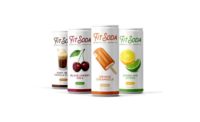Get FAT to Get Fit

If there were an elixir of life it would probably contain one of the polyunsaturated fatty acids (PUFA). Specifically, omega-3 has exhibited the ability to prevent heart disease, lower blood pressure, protect post-menopausal women against cancer, fend off depression and improve love life. Although the benefits of omega-6 fatty acids are less touted, studies do show the ratio of omega-3 to omega-6 is important to disease prevention.
Research is also continuing to delve into the health advantages of other nutritional lipids such as conjugated linoleic acid (CLA), which may play a role in diets for those concerned with weight loss or diabetes. As companies strive to attract consumers, decisions on how to formulate and market nutritionally enhanced products will continue to be critical.

Eggs-actly
"People, by nature, prefer to eat food rather than pop pills," states Michael Hawes, president of Belovo Inc., USA (Pinehurst, N.C.), a Belgium-based company that sells Christopher Brand Eggs, which are naturally enriched with omega-3 and omega-6 fatty acids. Increasingly, U.S. companies are offering prepared and processed foods enriched with PUFAs (or ingredients containing them). However, other countries have been enriching prepared foods with omega fatty acids for some time now.
Last year, the Christopher Egg (Bastion, Belgium) was test marketed in 500 South-Central Wal-Mart (Bentonville, Ark.) stores in the U. S. Wal-Mart was so impressed with the product that it decided to carry the omega-rich egg in all stores starting in February 2004, making it the only national premium egg brand, according to the company (see "Going Global" for full story).
A whole new world is beginning to open up for omega-enriched products. Although omega dietary supplements still dominated in 2003, the variety of prepared foods containing higher levels of omega-3 and omega-6 was more noticeable in the U.S. market. As expected, cold-water fish, supplements and health bars remained popular, and infant formula came into its own this year. According to results from Mintel's Global New Products Database (GNPD-Chicago), formula containing docosahexaenoic acid (DHA) and arachidonic acid (ARA) has grown immensely popular as a stimulant for brain and eye development in infants and children. Nestle© Good Start Supreme DHA & ARA Formula (Nestle USA, Glendale, Calif.) is formulated for brain and eye development, and includes omega-3 derived DHA extracts and omega-6 derived ARA from palm olein, soy, coconut and high-oleic safflower vegetable oils.
Competition Between the Omegas?
According to an article in the January 2003 issue of the Journal of the American Dietetic Association, the metabolic pathways of omega-3 and omega-6 fatty acids require the same enzymes, which cause competition between them. Too much of one family of fatty acids can interfere with the metabolism of the other.
In the past couple of years, flax seed has emerged as one of the more prominent sources of omega-3. According to the GNPD, in 2003, there were eight new prepared food products promoting a flax-derived omega-3 presence (as opposed to four pet food products in 2002). One new product, Health Valley's Empower cereal, from Hain-Celestial Group (Uniondale, N.Y.), contains organic flax seed and organic expeller-pressed canola oil while declaring 500mg of omega-3 fatty acids.
Another problem with omega-containing oils is the age-old formulation challenge of maintaining shelf stability. Vitamin E can be employed to reduce oxidation of unsaturated vegetable oils and prevent staling and off flavors; Health Valley used this solution for Empower cereal. In the case of Flax Premium Gourmet All-Natural Waffles (distributed by Van's International, Torrance, Calif.), which contain 1600mg of omega-3s, vitamin E and ascorbic acid were used to maintain freshness.
Microencapsulation of fish oils is another method used to retain shelflife. Nature's Mighty Bites (Methuen, Mass.) Soft Serve Ice Cream, enriched with omega-3 fatty acids from microencapsulated fish oils, became available September 2003 in Mighty Chocolate and Mighty Vanilla flavors. The dessert contains EPA and DHA, both proponents against high blood pressure.
Hemp is another omega source that has made an appearance in everything from powdered beverages to veggie burgers in North America. Ice cream, soy milk and margarines are only a few of the new omega-3 fortified food products that weren't around in 2002.
Another Unsaturated Fatty Acid
Diabetics have been encouraged to supplement their meals with conjugated linoleic acid (CLA), a natural dietary component metabolized from omega-6 fatty acids, created in the stomachs of ruminants, and found in dairy products, beef and lamb. CLA is said to protect against cancer, heart disease, obesity and diet-related diseases. It also inhibits inflammation and proliferation of human tumor cell lines. Researchers are working to increase the amount of CLA in dairy products but, in 2003, according to the GNPD, the only food products of which to speak were health and weight loss supplements, and snack bars.
CLA also has become popular because (though scientific research does not conclusively defend it) many believe CLA builds muscle and reduces fat. One product that touts this claim is chocolate and peanut butter-flavored Myoplex Deluxe Nutrition Bar (EAS, Golden, Colo.), launched in July 2003, which contains conjugated calcium linoleate (CLA) from sunflower oil.
Sidebar 1:
Going Global
Imagine getting the same amount of omega-3 from an egg that you would get from 50g of farmed raised salmon. "One of our eggs is equivalent [approximately] to an equal portion of salmon,"? says Hawes, president of Bolovo USA. Over the past seven years, Bolovo has sub-licensed its exclusive feeding system to egg producers around the world including the U.K., Australia, France, Germany, Japan and the U.S.
The Columbus Egg, distributed by Bolovo Inc., is not a new product to the E.U., but its twin, the Christopher Egg, recently broke ground in the U.S. Each Columbus and Christopher Egg contains over 600mg of omega-3 fatty acids, while standard eggs contain only 35-40mg. Most premium eggs with an omega-3 enriched claim are supplied by hens that eat ground up fishmeal and algae diets. They generally contain between 100-150mg per egg, says Hawes. Fabien de Meester, Ph.D., a dietician for hens, started Bolovo Inc. 10 years ago in Bastion, Belgium, and based the exclusive feeding system, which is hormone-free, on the premise that a hen would eat a natural balanced diet, given the opportunity to eat like it would in the wild. "We don't use a single ingredient that is out of proportion to everything else," affirms Hawes.
The 1:1 ratio of omega-6 to omega-3 is another characteristic that sets the Bolovo eggs apart from other premium eggs that, according to Hawes, contain approximately seven times more omega-6. "The Western diet is about 22 times too rich in omega-6 and we don't get near enough omega-3,"? says Hawes. Studies conducted by the Center for Genetics Nutrition and Heath at the National Institute of Health (Washington) suggest that health risks increase when omega-6 exceeds omega-3 in significant proportions.
Links
- Two articles on CLA
- The importance of the ratio of omega-6/omega-3 essential fatty acids
- American Dietetic Association
- The Center for Genetics, Nutrition and Health, Washington, DC 20009, USA
- American Heart Association
- Health Notes
- from Mintel International's Global New Products Database
- Omega-3 information service
Looking for a reprint of this article?
From high-res PDFs to custom plaques, order your copy today!




